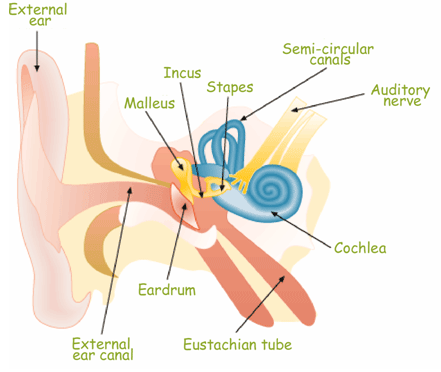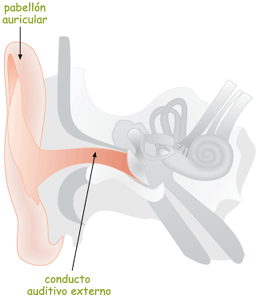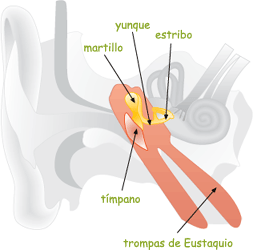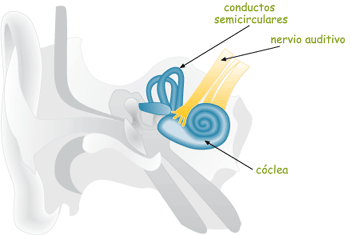Otitis is such a common condition that you have probably had it at one time or another.
The ears are truly a marvel of engineering. They are vitally important in enabling us to hear well and walk upright. The ears have hidden secrets. They hide our sense of hearing. Come on in and find out for yourself!!!
Here we explain what it is!
The Ear
Before talking about ear conditions, we ought to know how the ear is structured.

The ear consists of three parts:
- The external ear
- The middle ear
- The inner ear
The external ear
The external ear consists of the auricle, what is commonly known as the ear flap, and the external ear canal. The ear flap’s funny type of skin is called cartilage.

You already know that sound travels in wavesthrough the air. The sound waves enter this part of the ear which, thanks to the auditory canal, can orientate and direct the sounds coming in from outside towards the eardrum, which is in the middle ear.
The external ear is also where ear wax is made, which comprises special chemical substances that fight infection and help to keep the auditory canal clean.
Middle ear
The middle ear is also known as the tympanic cavity and, as one may suppose, is situated between the external ear and the inner ear.

In fact, we could say that it is a chamber that is connected with the throat via the Eustachian tube, which acts like a valve regulating the pressure inside the middle ear and which connects up with the external auditory canal via the tympanic membrane or eardrum.
The eardrum is a very fine membrane that separates the external ear from the inner ear, and just behind it lie three tiny little bones known as the malleus, incus and stapes. This last one, the stapes, is the smallest bone in the whole body.
Altogether, the ear structures are very delicate and their functioning is very complicated, because the sound reaching the membrane (eardrum) has to be adapted and conducted through to the inner ear.
A large part of the work done by the middle ear consists in regulating the pressure. That’s why the Eustachian tube is so important. This tube-like structure is usually closed, except when we yawn or swallow, when it opens. If you’ve ever been in an aeroplane or up a mountain you’ve probably felt your ears go “pop”. That’s nothing more than the Eustachian tube opening up to make sure the air pressure is the same on both sides of the eardrum, that is, inside and outside the ear.
If this pressure were not kept regulated … our ears might burst!!
Inner ear
The inner ear is a very hard bony structure,covered by a membrane full of fluids which, when they move, stimulate the nerve cells.

It consists of two receiver units, which work differently:
- The cochlea, which governs hearing
- The sistema vestibular, which governs balance.
So, after the sound waves have entered the external ear and been turned into vibrations in the middle ear, the inner ear gets to work.
The vibrations reach the cochlea, a small spiral tube forming part of the inner ear and which is full of fluid. When the vibrations touch it, the fluid starts to vibrate, stimulating the nerve endings and creating an electrical impulse which travels along the auditory nerve to the part of the brain that translates it into sound.
The brain would never be able to recognise what reaches it – in this case, sound – if all the parts of the ear were not working in unison.
Just above the cochlea are the semicircular canals,which also contain fluid and thousands of tiny, microscopic cell endings. These canals are responsible for us keeping our balance.
For example, if you bend down, the fluid in the semicircular canals moves and in turn makes the cell endings move, thereby relaying a message to the brain regarding the position of your head. In less than a second, the brain knows what position your head is in and which muscles it has to inform so that you won’t lose your balance and fall over.
Otitis
Otitis is an infection and one of the commonest conditions or ailments among children and young people.
It is caused by a virus or bacteria that gets into the middle ear from the nose or throat via the Eustachian tube.However, otitis can also affect the inner ear.
There are different types of otitis, depending on the part of the ear that is affected:
- Otitis externa
- Otitis media
- Chronic otitis media
- Secretory otitis media
Sometimes, otitis externa is called “swimmer’s ear“, because it can be caused by the constant contact of water with the ear.
Physical examination of the ear with the appropriate instrument, the otoscope, can discern the typical signs of otitis. For example, in the case of otitis externa, the ear is often red, while in the case of otitis media there is inflammation of the eardrum as well as redness.
Otitis types
It is one of the main infections of the external ear. Humidity causes alterations in the skin and macerations which change the skin balance and make it become weaker to face the infection.
Otitis media
The infection of the middle ear can spread all over the structures of the head. This is why it is very important to treat it and stop it in time. This type of otitis is very common among children.
Otitis must be seriously treated as it may cause deafness.
This type of otitis is caused by the dysfunction/malfunction of the Eustachian tube. Often, before the ear hurts due to the otitis, one has already got a cold. This makes the tube close a bit, and impairs proper ventilation of this part of the middle ear. It is very important to cure completely this type of otitis to avoid it becoming chronic.
Chronic otitis media
In this case, the infectious process causes the eardrum perforation and develops a mild deafness, depending on the state of the middle ear.
Serous otitis
This type of otitis also occurs in the middle ear and is caracterized by the segregation of a seromucous fluid inside the tympanic cavity. In this case, the Eustachian tube is completely blocked. A negative pressure is created inside the tympanic cavity, so the serous fluid accumulates easily. Although we are talking about ears, it is very important to know how to blow one’s nose properly, and our nose has to be always very clean. They must be always expired and never inspired. It is estimated that over 80% of children will suffer from serous otitis before the age of six.
Symptoms
There are different symptoms to indicate that you may have otitis:
- Persistent pain in the ear.
- Itching or discomfort in the ear.
- Loss of hearing.
- A whistling sound in the ear.
- A temperature.
- Shivering.
- Feeling restless or irritable.
- Feeling generally unwell.
- Nausea and vomiting.
- Diarrhoea.
Treatment
 The aim of treatment is, of course, to get rid of the infection. When the infection is due to bacteria, you’ll have to take a course of antibiotics, at the dose and for the length of time necessary.
The aim of treatment is, of course, to get rid of the infection. When the infection is due to bacteria, you’ll have to take a course of antibiotics, at the dose and for the length of time necessary.
Sometimes, as a complement to the antibiotic treatment and if the condition is very painful, painkillers may be taken, and heat applied to the affected area also helps to alleviate the pain.
Generally speaking, the treatment is effective and there are no further complications. If after several days you have no more pain, it means the otitis has cleared; however, if the pain returns, you must go back to the doctor or pharmacist and resume or change your treatment.
Whenever you have earache, it is very important not to mess about with your ear or scratch it with your finger or any other object.
When the infection has cleared, make sure you always keep your ears clean and dry.
What should you do?
There are several things you can do to help prevent otitis:
- Dry your ears carefully after showering, bathing or washing your hair.
- Use earplugs when swimming.
- Not swim in contaminated water.
Ear hygiene
If you put your finger in your ear, you may come across a yellowish or brownish substance which is the earwax. This is formed from secretions of the sebaceous and ceruminous glands of the skin, along with hairs and dirt.
Earwax has a protective action, lubricating the skin and preventing infection. In a way, you could say that the ears have their own system of cleaning and disinfection.
We should always keep our ears clean and dry, but we should NEVER use any cotton buds or other instruments for cleaning further in beyond the external ear.